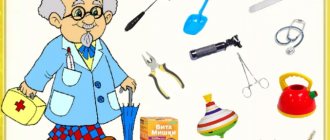Master class “Health-saving technologies in preschool educational institutions”
We cook, we cook compote. (Again “cook” and “stir.”)
Let's treat honest people.
Game for developing breathing “Labyrinth”
Target:
Increase breathing volume, normalize its rhythm
Develop a smooth, long, economical exhalation
Activate the work of the lip muscles.
During the described games and exercises, constant monitoring of the teacher over correct breathing is necessary.
Equipment for the Game "Maze"
(made on the basis of plywood with cut out moves) “ball” made of paper or foil (you can also use a table tennis ball).
The rules for conducting the game “LABYRINTH”:
The game can be played by several people in turns. Use your breath to guide the ball out of the maze. The labyrinth is designed in such a way that during the game the child has to blow with different strengths (during the game, monitor the child’s breathing: inhale through the nose and exhale through the mouth; do not puff out the cheeks) The game also reinforces the names of geometric shapes, colors, Offer self-massage of palms.
Booklet green color
Play activity
increases interest in physical education and sports. But not only outdoor or sports games increase interest, but also didactic games.
I present to your attention the didactic manual “Flower of Health”
— Didactic game “Guess the sport by showing it”
Booklet yellow color
Emotional sphere
can be considered as one of the fundamental internal factors that determine the child’s mental health and the development of his initially prosperous psyche. With the help of didactic games, it is possible to develop emotional well-being in preschool children.
— Didactic game “Guess the emotion by showing it”
Orange color of the booklet
Relaxation
- this is the ability to relax, it helps some children relieve tension, others - concentrate attention, relieve excitement.
"Traveling on a Cloud"
Sit comfortably and close your eyes. Inhale and exhale deeply two to three times. I want to invite you on a journey on a cloud. Jump onto a white fluffy cloud that looks like a soft mountain of plump pillows. Feel how your legs, back, butt are comfortably located on this large cloudy pillow. Now the journey begins. The cloud slowly rises into the blue sky. Do you feel the wind blowing across your faces? Here, high in the sky, everything is calm and quiet. Let the cloud take you now to a place where you will be happy. Try to mentally see this place as accurately as possible. Here you feel completely calm and happy. Something wonderful and magical can happen here. Now you are back on your cloud, and it is taking you back to your place in the classroom. Get off the cloud and thank it for giving you such a good ride. Now watch it slowly melt into the air. Stretch, straighten up, and be cheerful, fresh and attentive again
Master class “Be healthy, teacher”
It is well known that the teaching profession is one of the most energy-intensive. Its implementation requires enormous intellectual, emotional and mental costs.
In recent years, the problem of preserving the mental health of teachers has become especially relevant. The modern world dictates its own rules: the demands from parents on the personality of the teacher and his role in the educational process have increased. Transformations in the education system also raise the bar: a creative approach to work, innovation, project activities, and pedagogical technologies are encouraged.
Not only does the academic workload increase, but along with it the neuropsychic stress of the individual and overwork also increases. Various types of overload are aggravated by numerous fears: fear of being abandoned, not finding support; fear of being unprofessional; fear of control.
This situation quickly leads to emotional exhaustion of teachers, known as «
emotional burnout syndrome."
Emotional burnout is
a kind of psychological defense mechanism developed by the individual in the form of complete or partial exclusion of emotions in response to traumatic influences. The professional activities of teachers are replete with factors that provoke emotional burnout: high emotional load, a huge number of emotional factors, the daily and hourly need for empathy, sympathy, responsibility for the lives and health of children.
“Emotionally burnt out” teachers are characterized by increased anxiety and aggressiveness, categoricalness and strict self-censorship. These manifestations significantly limit creativity and freedom, professional growth, and the desire for self-improvement. As a result, the teacher’s personality undergoes a number of deformations such as inflexibility of thinking, excessive straightforwardness, instructive manner of speaking, excessive explanations, thought patterns, and authoritarianism. The teacher becomes a kind of “walking encyclopedia”: he knows what is needed, how it is needed, when, why and how, and how it will all end. But at the same time, he becomes absolutely closed and impervious to any innovations and changes.
In addition, teaching teams are, as a rule, same-sex, and this is an additional source of conflict. As a result, the teacher becomes a hostage to the situation of emotional burnout, a prisoner of stereotypes of emotional and professional behavior.
This is very harmful for the teacher, as it gives rise to psychosomatic illnesses and increases the manifestation of chronic diseases. Among other things, many teachers do not have the opportunity to fully restore their health - to purchase quality products, to go on vacation to boarding houses or sanatoriums in the summer.




